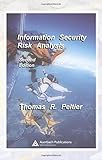Information security risk analysis / Thomas R. Peltier.
Material type: TextPublication details: Boca Raton : Auerbach Publications, 2005.Edition: 2nd edDescription: xvi, 344 p. : ill. ; 24 cmISBN:
TextPublication details: Boca Raton : Auerbach Publications, 2005.Edition: 2nd edDescription: xvi, 344 p. : ill. ; 24 cmISBN: - 9780849333460
- 005.8 22
| Item type | Current library | Call number | Copy number | Status | Date due | Barcode | |
|---|---|---|---|---|---|---|---|
 Books
Books
|
Main library General Stacks | 005.8 / PR.I 2005 (Browse shelf(Opens below)) | 1 | Available | 002609 |
Browsing Main library shelves, Shelving location: General Stacks Close shelf browser (Hides shelf browser)

|

|

|

|

|

|

|
||
| 005.8 / PA.I 2009 Implementing Cisco IOS network security (IINS) / | 005.8 / PE. I 2002 Information security policies, procedures, and standards : | 005.8 / PE.S 2008 Software testing and analysis : | 005.8 / PR.I 2005 Information security risk analysis / | 005.8 / RA.M 2006 Microsoft internet security and acceleration (isa) server 2004 administrator’s pocket consultant / | 005.8 / RU.H 2001 Hack Proofing Your e-Commerce Web Site: | 005.8 / SH.C 2011 Cybersecurity : |
Includes bibliographical references and index.
Information Security Risk Analysis, Second Edition enables CIOs, CSOs, and MIS managers to understand when, why, and how risk assessments and analyses can be conducted effectively. This book discusses the principle of risk management and its three key elements: risk analysis, risk assessment, and vulnerability assessment. It examines the differences between quantitative and qualitative risk assessment, and details how various types of qualitative risk assessment can be applied to the assessment process. The text offers a thorough discussion of recent changes to FRAAP and the need to develop a pre-screening method for risk assessment and business impact analysis.
Using the PARA (Practical Application of Risk Analysis) process, this book examines the qualitative risk analysis process and then provides tested variations on the methodology that will allow any organization to implement risk management techniques that will prove to be cost effective. The PARA process can be used by any organization that needs to determine what direction the organization must take on a specific issue.
1
There are no comments on this title.
